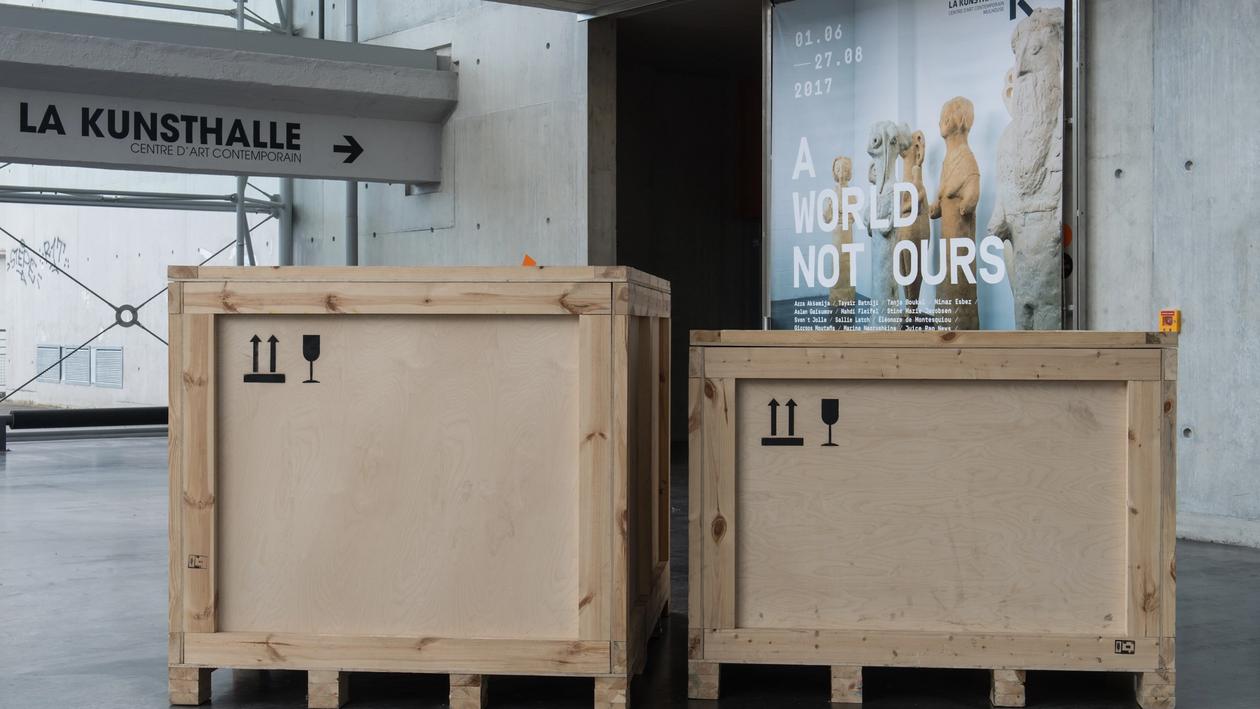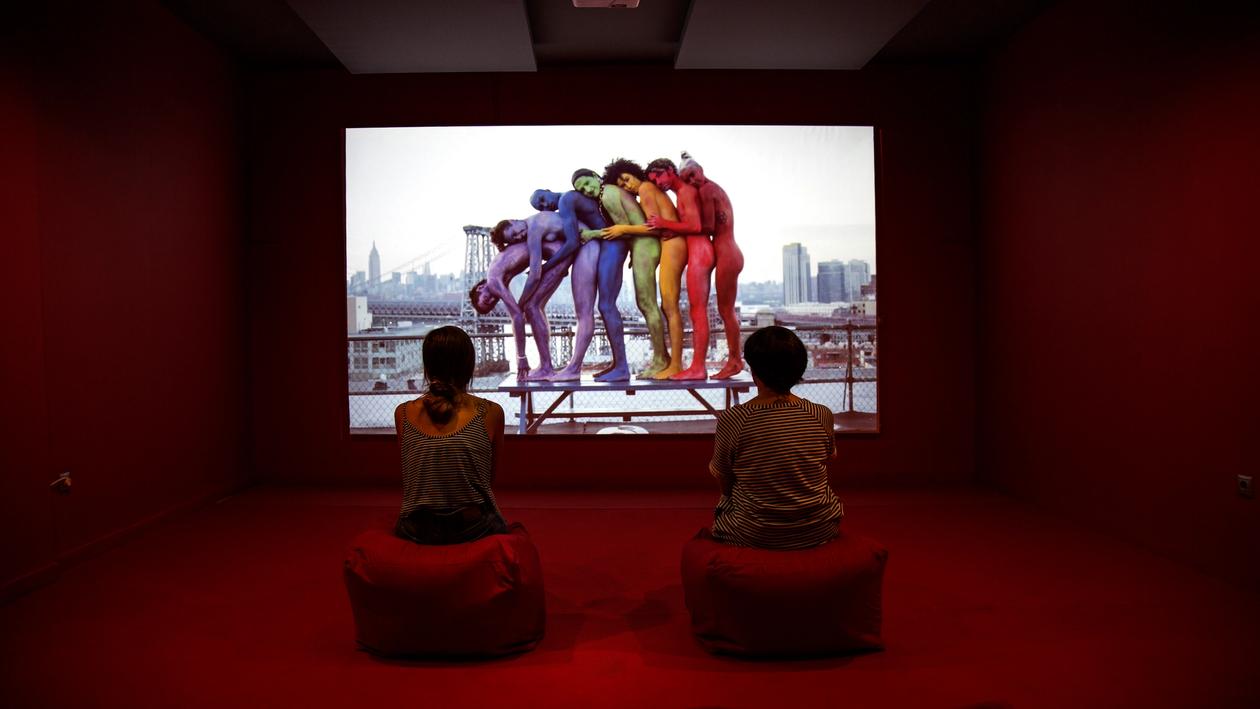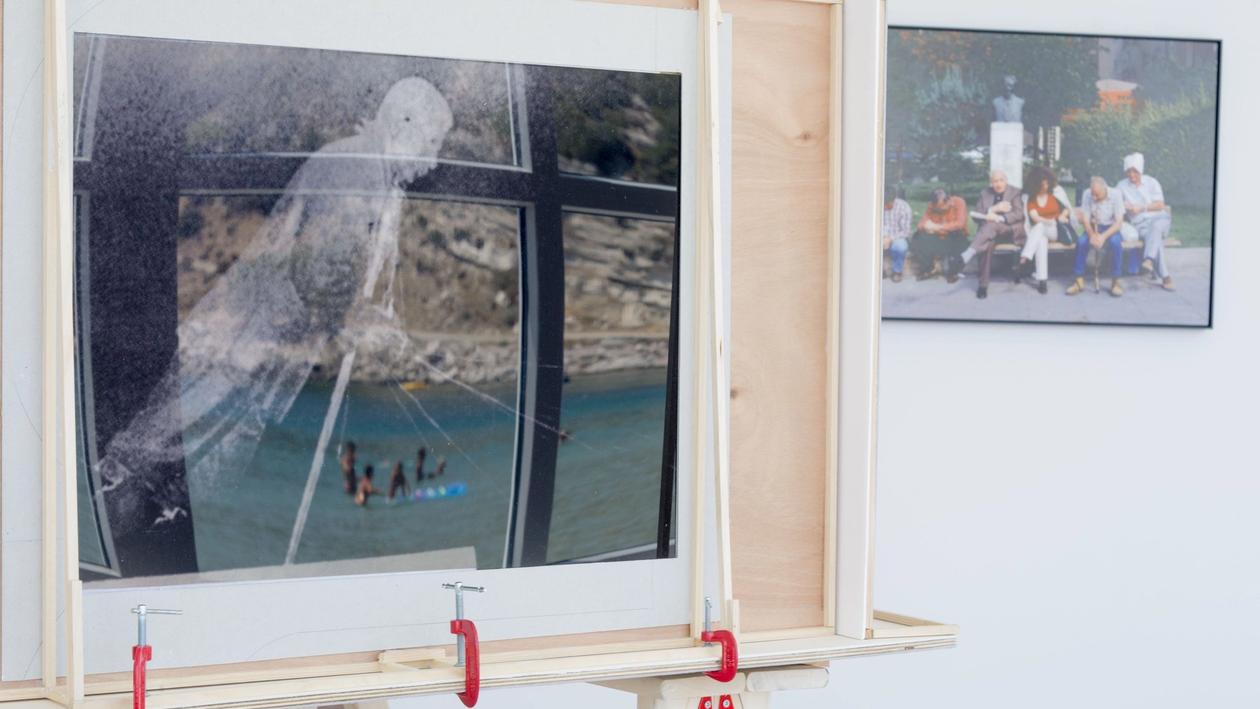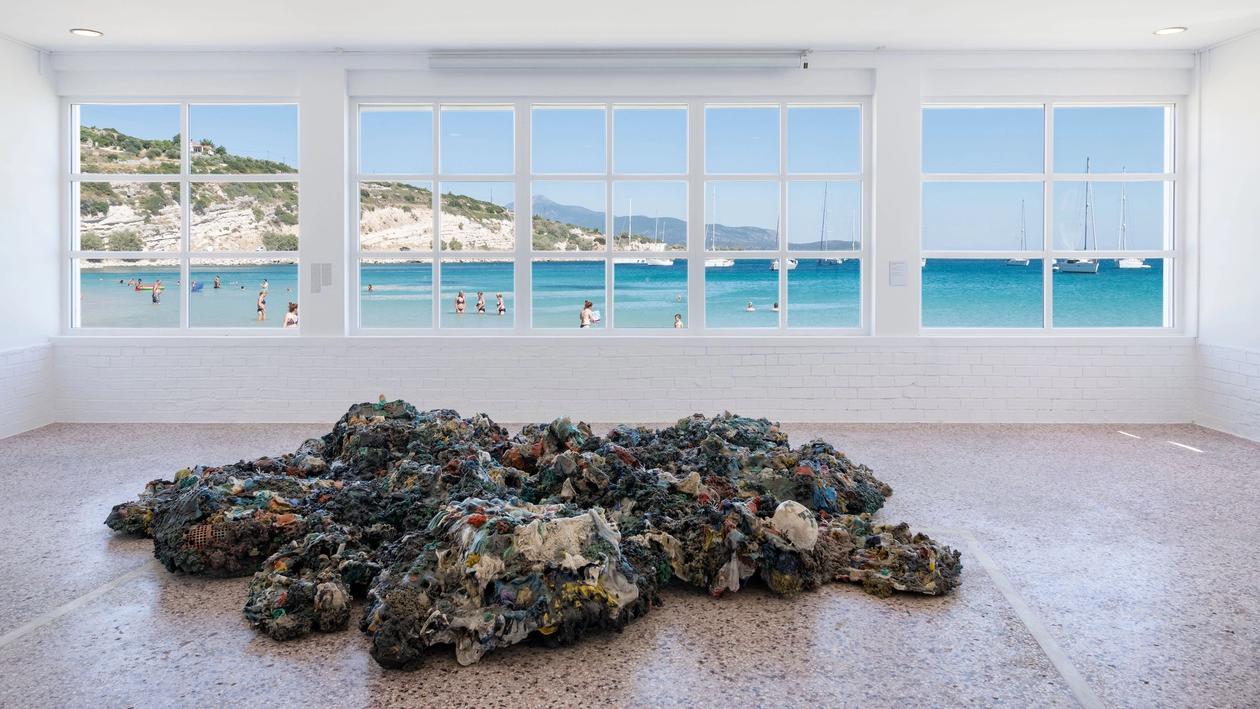
A World Not Ours 2016


Participation Artists
Curator
A World Not Ours
Text by Katerina Gregos
A World Not Ours, the summer exhibition for Art Space Pythagorion, Samos, borrows its title from the award-winning homonymous 2012 film by director Mahdi Fleifel, which in turn borrows its name from a book by the Palestinian writer Ghassan Kanafani (1936–72). The film is a portrait of three generations of exile in the refugee camp of Ein el-Helweh, in southern Lebanon, while the book speaks about diaspora and the search for identity. The exhibition takes place in a location which has been at the heart of the refugee crisis that began in 2015, largely as a result of the war in Syria, reflecting on this ongoing crisis. Samos is one of the three Greek islands (together with Lesbos and Kos) closest to the Turkish coast, and as such has been at the crux of this humanitarian tragedy that has been played out on the region’s shores. Given the highly charged location, it is vital that an art exhibition here should address this situation, which has been an unremitting reality on the island, and a pressing, unresolved issue for the whole of Europe. The exhibition focuses on the issue of the refugee crisis and forced migration by bringing together a group of artists, photographers, filmmakers and activists who offer different reactions, reflections, and analyses on the subject. Bringing together diverse practices from installation, performance, photography, film, video and photojournalism, the participants in the exhibition largely transcend one-sided and standardised media representations of the crisis (mostly consisting of rickety boats and images related to the perilous sea crossing) and look into the before and after this dramatic moment. The work on view provides deeper insight into the plight of the refugees, from a humanitarian point of view, acknowledges the complex roots of one of the most pressing issues of our time, while contextualising it into the larger global picture. A key idea underlying the exhibition is also that of engendering empathy — which is perhaps one of the things that can spur us to action. It considers what Susan Sontag has said that we often see pain in images but we cannot feel it. Therefore it aims to make the whole issue more palpable and tangible for the public.
Harnessing methods that range from activism and direct action to poetics and metaphor, the participants in the exhibition consider the issues of forced displacement and the experience of homelessness, perpetual insecurity, diasporic identity and existential limbo. The work that is on view is the result of in-depth, long-term research, on-the-ground engagement and first-hand experience. The works here offer genuine empathy and sincere motivation, as opposed to what Tirdad Zolghadr has been called “poornography”1: the use of images of poverty and precariousness to create sensational images in the media as well as in art. In the contemporary art world, the refugee crisis has unfortunately engendered opportunism, with some rushing in to profess their engagement by producing facile one-liners and generating publicity for their own sake (see endnote). This exhibition, rather, includes artists who opt for a nuanced way of working with these highly sensitive issues, who stay under the radar, working with discretion, thoughtfulness and beneficence. Many of the participants come from the Middle East or south-eastern Europe, from countries that have experienced war, trauma, exodus and perilousness first hand.
- Thursday, August 4
Public Programme
- Saturday, August 6
Artists' Talks & Film Screening
- Tanja BoukalArtist
- Sunday, August 7
Artists' Talks Public Programme
- Ninar EsberArtist
- Marina GiotiArtist
Ninar Esber, The Blind Lighthouse, 2016
Documentation of performance at Art Space Pythagorion
Commissioned by the Schwarz Foundation
Courtesy the artist and Galerie Imane Farès, Paris
Stelios Markou, Litsa Stamna-Markou and Xenia Hatzinikolaou, members of Samos Theatre Group, reading of a series of interviews with refugees and volunteers on Samos, by Sallie Latch.
Cine Rex in Mytilinioi, Samos
Ninar Esber, The Blind Lighthouse, 2016
Documentation of performance at Art Space Pythagorion
Commissioned by the Schwarz Foundation
Courtesy the artist and Galerie Imane Farès, Paris
Stelios Markou, Litsa Stamna-Markou and Xenia Hatzinikolaou, members of Samos Theatre Group, reading of a series of interviews with refugees and volunteers on Samos, by Sallie Latch.
Cine Rex in Mytilinioi, Samos
Curatorial Residency Program
The art curatorial residency programme is a Schwarz Foundation initiative aiming to bring together young professionals from different fields of science and art. Participants acquire professional experience by actively working together with internationally acclaimed art curators. In the inspiring ambiance of a historic and cultural area of high geographic importance, residents work at a freshhold between West and East. Residents meet, interact and develop ideas and references to an extensive community. The residents actively participate in the curating and production of the Art Space Pythagorion exhibition under the curator’s guidance. The production of complementary side-events, such as opening activities, lectures, workshops, educational programmes for children and screenings also fall in their line of work.
- Resident Curators
- Maria-Ioli TzannetakiResident Curator
- Faidra VasileiadouResident Curator
- Yannis DrakopoulosResident Curator
- Sarita PatnaikResident Curator
- Panos GiannikopoulosResident Curator
Educational Program
The educational program designed and implemented by the artist Katerina Zacharopoulou and the resident curators in the context of the exhibition was based on the work of the participating artists and takes into account the childrens’ tendency for sympathy for the other, the special conditions on the island of Samos due to the refugee crisis, the need for solidarity and adaptation to our changing world.
The program was addressed to children and teenagers but also to the teachers of Samos with a series of creative meetings at the exhibition space. It introduced children to a public art space and initiated discussions about photography, film, photojournalism, sustainability, the myriad reasons behind migration, borders, history and empathy. It lasted 2 hours and was accompanied by a specially designed "Notebook" with images from the works of the exhibition, where the children were able to draw, write, express their emotions. At the same time, they were invited to build their own imaginary house for the refugees, a tale about Fear and the Stranger, to talk about personalbelongings related to family stories, to send a letter to the participating artists narrating the experience they gained from their works.
The exhibition was officially scheduled to close on October 15 but the duration was extended for one month, following a request from schools of Samos. A total of 887 students have participated in the program, accompanied by their teachers.
Addtionally, in cooperation with the United Nations High Commissioner for Refugees, the organization METADRASI and the Reception and Identification Service of the Ministry of Migration & Asylum, a total of 116 of children travelled from the refugee facilities in Vathy Samos (Vathy RIC) to visit “A World Not Ours”. Mostly Arabic-speaking children (Syria) but also children belonging to other ethnic groups have visited Art Space Pythagorion accompanied by their compatriots, parents, and teachers. It is important to emphasize the contribution of specialist psychologists and child psychologists in the adaptation and translation of the textbook into Arabic. With the help of Medin Medical Intervention and Médecins Sans Frontières, the experience of children was taken into careful consideration.
Curator of Education
Press
- 2016 Art Space Pythagorion Press Review Download
- Anti-utopias, A World Not Ours. Curated by Katerina Gregos (EN)
- Financial Times, Maya Jaggi, A new art show on the frontline of the refugee crisis (EN)
- artnet news, Hili Perlson (Review), On Samos, Greece, a Show Takes an Intimate Look at the Refugee Crisis (EN)
- Monopol, Donna Schons, Die schwindende Macht der Bilder (DE)
- Die Welt, Anne Waak, Ferien für immer (DE)
- FAZ - Frankfurter Allgemeine Zeitung, Kolja Reichert, Die Kunst der guten Absichten (DE)
- Tagesspiegel, Bernhard Schulz, Auch Griechen flüchteten nach Samos (DE)
- Kathimerini, Margarita Pournara, Κοιτάζοντας κατάματα την αλήθεια (GR)
- ελculture, Argyro Bozoni, Το Πυθαγόρειο της Σάμου έχει ένα λόγο να υπερηφανεύεται (GR)
- ελculture, Argyro Bozoni, Eκπαιδευτικό Πρόγραμμα στο πλαίσιο της έκθεσης "A World Not Ours" (GR)
- ελculture, Argyro Bozoni,«Πιστεύω ότι αν η τέχνη διδασκότανε στα σχολεία, θα ήμασταν ίσως πιο πολιτισμένοι και λίγο καλύτεροι άνθρωποι» (GR)
- EfSyn, Pari Spinou, Καλλιτέχνες χωρίς σύνορα για το προσφυγικό (GR)
- To Vima, Marilena Astrapellou, Η Σάμος δείχνει τον δρόμο (GR)
Exhibition Brochure
Credits
- Exhibition concept/curator: Katerina Gregos; Curatorial assistant: Sarita Patnaik; Production / installation: Yorgos Efstathoulidis/Constructivist ; Supervisor: Danae Giamalaki; Exhibition Architect: Penny Petrakou; Audio-visual: M-SPIRIT ΜΟΝ. / Kostas Perifanos ; Film production / direction: Theo Prodromidis; International media relations: Goldmann Public Relations, Munich; Greek media relations: Zuma Communications, Athens; Educational programme: Katerina Zacharopoulou; Curatorial Residents:Giannis Drakopoulos, Panos Giannikopoulos, Ioli Tzanetaki, Sarita Patnaik, Faidra Vasileiadou; Assistants: Vassilis Pristouris, Despina Tsirigou, Evagelia Vakiarou, Eleni Maria Loulourga; Graphic design: Daniel Schnitterbaum ; Printing: image, Samos; Translations: Tony Moser (English to Greek); Proofreading: Tony Moser
Thanks to the Fondation Cartier, Paris for the loan of the work EXIT
Special Thanks to
- The Municipality of Samos, Municipal Harbor Fund of Samos, Port Authority of Pythagorion




